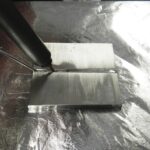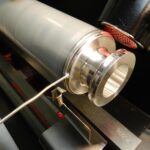Aluminum soldering is used in making small area electrical and/or thermal connections or seals to other metal or ceramics, while aluminum bonding is used to join large areas either for thermal and/or structural purposes. Aluminum soldering finds applications in sensors, electronics, and electrical power where aluminum contact and/or wire leads are being utilized. Aluminum soldering has also been used as a means to seal and/or repair aluminum heat exchangers.
We have been contacted many times for assistance in solving the problem of small contact to aluminum without the use of aggressive chemical flux or cases where the chemical flux for aluminum was not compatible with the metals of the opposing side of the joint. Additionally, in many electronic packages the use of corrosive aluminum soldering fluxed are limiting When faced with these choices, active fluxless solders such as S-Bond become a good solution.
S-Bond® active alloys have been developed join to a wide range of metals, ceramics, and composite materials without the need for fluxes or preplating. S-Bond solder alloys have a strong affinity for bonding to aluminum, making aluminum soldering simpler, more cost effective, and more reliable. Just melt the S-Bond filler metals, mechanically agitate S-Bond solders via brushing, rubbing, or via ultrasonically activated solder irons to wet, adhere and provide a base for joining. Once tinned with S-Bond solders wire leads or other surfaces are pressed, slid together or ultrasonically activated to create a strong solder joint.
S-Bond Aluminum Soldering has the following characteristics:
• Permits the joining of aluminum to copper and other metals and ceramics without flux.
• Flux free joining eliminates contamination and need for cleaning.
• Lower temperature solders (from 115° – 250°C) permit soldering to thermally sensitive materials.
• S-Bond (solder) produces metallic joints that are electrically and thermally conductive.
• Metal plating is not required to prepare aluminum surfaces thus lowering preparation costs.
• S-Bond solders do not flow freely and do not bond to areas adjacent aluminum soldering areas without the direct application of mechanical activation.
Applications
Solar Panels: Figure 1 illustrates the bonding of tinned copper leads are soldered to aluminized layers on the back of silicon solar panels. Active S-Bond solder buss lead joints to back of these panels are proving to be more effective and stronger than conventionally soldered connections.
Aluminum Heat Exchanger Solder Repairs: Figures 2 and 3 show the ultrasonic soldering of aluminum panels and the filling of cut outs made in leaking aluminum heat exchanger brazed joints.
Hermetic Sensor Enclosures: Figures 4 and 5 illustrate the active S-Bond solder sealing of aluminum sensor enclosures. The picture indicate aluminum soldering with active solders being activated and bonded to seal an aluminum cap to an aluminum tube.
Contact Us for more information on aluminum soldering. To order our materials for testing, request a kit order form. Soldering services are also offered for testing, prototyping and production.





